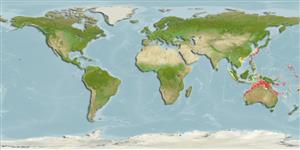Environment: milieu / climate zone / depth range / distribution range
Écologie
marin démersal; profondeur 40 - 82 m (Ref. 39927). Tropical
Western Central Pacific: northwestern Australia and the South China Sea; undoubtedly widespread.
Taille / Poids / Âge
Maturity: Lm ? range ? - ? cm
Max length : 2.2 cm SL mâle / non sexé; (Ref. 39927)
Description synthétique
Clés d'identification | Morphologie | Morphométrie
Épines dorsales (Total) : 7; Rayons mous dorsaux (Total) : 8 - 10; Épines anales: 1; Rayons mous anaux: 7 - 8. Second dorsal usually with 1 spine and 9 soft rays; first dorsal spine filamentous, reaching near end of second dorsal fin. Pectoral fin 17-19 (rarely 17). Pelvic fin with complete basal membrane and a fraenum, forming a typical gobiid cup-shaped disc. Anterior nasal tube short, 5.7- 7% HL; distal quarter of tube black. Pores present: a posterior nasal, an anterior and a posterior interorbital, a postocular, an infraorbital and 2 preoperculars. Midline of belly naked (Ref. 39927).
Known from dredge and trawl samples, from areas with encrusting invertebrates (e.g. sponges) (Ref. 39927).
Life cycle and mating behavior
Maturities | Reproduction | Spawnings | Egg(s) | Fecundities | Larves
Winterbottom, R. and D.F. Hoese, 1998. A new genus and four new species of fishes from the Indo-West Pacific (Pisces; Perciformes; Gobiidae), with comments on relationships. R. Ont. Mus. Life Sci. Occas. Pap. (37):1-17. (Ref. 39927)
Statut dans la liste rouge de l'IUCN (Ref. 130435)
Menace pour l'homme
Harmless
Utilisations par l'homme
Outils
Articles particuliers
Télécharger en XML
Sources Internet
Estimates based on models
Preferred temperature (Ref.
123201): 23.3 - 28.2, mean 27.3 °C (based on 118 cells).
Phylogenetic diversity index (Ref.
82804): PD
50 = 0.5078 [Uniqueness, from 0.5 = low to 2.0 = high].
Bayesian length-weight: a=0.01023 (0.00477 - 0.02194), b=3.02 (2.84 - 3.20), in cm total length, based on LWR estimates for this (Sub)family-body shape (Ref.
93245).
Niveau trophique (Ref.
69278): 3.1 ±0.3 se; based on size and trophs of closest relatives
Résilience (Ref.
120179): Faible, temps minimum de doublement de population : 4,5 à 14 années (Assumed Fec < 100).
Fishing Vulnerability (Ref.
59153): Low vulnerability (10 of 100).
